Pages: 18
Publication: 10 July 2020
Authors: Paul Besson, Head of Quantitative Research and Théo Compérot, Quant Research Analyst
VBBO Trading: a best execution solution for retail investors or for market makers?
On average there is an overall negative price improvement of −0.5 bps for VBBO trading vs EBBO. These deteriorations worsen with wider spread and larger trade sizes (see Table 2, p7)
- We observe a strong negative relationship between the trade size and the price improvement of Volume Weighted Best Bid and Offer (VBBO) trades. The larger the trade size, the more negative the price improvement (see Figure 7, p9). For example, the average improvement for a €2,500 trade is −0.4 bps, while it is −1.0 bp for a €7,500 trade.
- Likewise, we also observe a strong negative relationship between price improvement and average spread size (measured at the time of the trade). Thus, for a 5 bps spread we observe a −0.3 bps price improvement, while for an 18 bps spread we observe a −1.0 bp price improvement versus European Best Bid and Offer (EBBO) (see Figure 9, p10).
VBBO seems to be a better best execution solution for market makers than for retail investors
-
We show that the worsening of execution price versus EBBO (+0.5 bp on average) is mostly attributable to the cases where the second best limit price contributes to the VBBO. Enabling trading at a reference price including a second limit computation, when the first limit is still valid (see Figure 18, p15), provides a unique opportunity to the market maker to sell at a higher price than the available best ask (+4.1 bps), even 100 milliseconds after the trade took place.
-
Overall, buying at EBBO +0.5 bps should not necessarily be considered as a proof of best execution for a retail order. This net reference is achieved by most compliant institutional investors. As evidenced by the improved quotes versus EBBO offered by market makers to retail investors, an execution price that is better than standard EBBO should be expected to demonstrate best execution for these highly prized flows.
-
More fundamentally, any kind of reference price system that does not allow market makers to compete on prices, thus prevents retail investors from benefitting from the price improvements these uninformed flows are entitled to receive. Therefore a central order book model with improved quotes for retail flows seems the most natural design to transparently pass on price improvements to retail investors.
Purpose
In this study we aim to compare Equiduct VBBO trades with the corresponding EBBO quotes to assess the performance of these types of trading. Performance of VBBO trading will be measured by the relative difference between executed prices and their corresponding EBBO reference prices. We have therefore reviewed all VBBO trades from Equiduct from December 2019 to February 2020. This corresponds to 1.16 million individual retail trades.
EBBO computations were provided by QuantHouse, the leader in high frequency data, chosen for its strong real-time data expertise.
We will focus on 4 main objectives:
- Compare prices for VBBO trades with EBBO prices to determine the price improvement or price deterioration observed in these trades;
- Study how this relative performance behaves with the corresponding underlying trade sizes and the bid-ask spreads of stocks;
- Explain the Equiduct VBBO trading performance by considering independently those trades with sizes available on the EBBO first limits, and larger trades with sizes that were not available on the EBBO first limits;
- Consider the question of best execution for VBBO trading.







